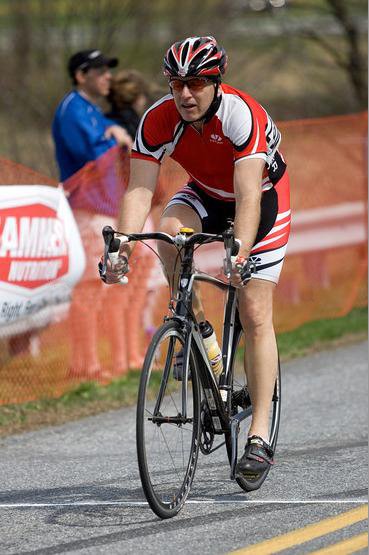 Here's the link for the 2011 Rulebook. Please read it. Knowing the rules will work to your advantage. Trust me. http://www.usacycling.org/forms/USAC_rulebook.pdf Here is a rule you should know, especially if you race Criteriums that relates to the Free Lap Rule, Rule 3D5 (d): A rider granted a free lap must re-enter the race before the final 8km of the race.
Here's the link for the 2011 Rulebook. Please read it. Knowing the rules will work to your advantage. Trust me. http://www.usacycling.org/forms/USAC_rulebook.pdf Here is a rule you should know, especially if you race Criteriums that relates to the Free Lap Rule, Rule 3D5 (d): A rider granted a free lap must re-enter the race before the final 8km of the race.So, lets say your Crit is advertised as 60 min. long instead of laps (like the Collegiate races). After a few laps of the race, the officials will average the time per lap. That's why you'll see the lap counter at 00 for the first few laps of your race- the officials are computing the number of laps remaining. If your average time per lap is 3 min. long you will most likely be doing 20 laps +/- 1 lap. If the Crit loop is 1.1 miles long, that means you'll be racing a total of 22 miles. 22 miles x 5280 ft./mile= 116,160 ft Divide that by 3.28 ft/meter= 35,414 meters Divide this number by 8000 meters (8km) and you get 4.4 laps. That will be the cut-off for a free lap. I believe the officials will round that off to either 4 or 5 laps.
If your average time per lap for the first few laps is 2.5 min (for the same race) that's 24 laps instead of 20 laps you'll be racing. 24 laps times 1.1 miles per lap = 26.4 miles. That translates to 5.3 laps. Therefore, your cutoff for a free lap will be either 5 or 6 laps. Oh, and that's 5 or 6 laps left in the race that the "leaders" see. So, if you're 1/2 mile behind the leaders and you flat out and see 5 or 6 on the lap counter (which is clearly displayed just past the finish line) then there are no more free laps. Hope this makes sense. If not, email me: mullerrj@comcast.net So, in general, for a 60 min. race with a 1.1 mile loop and an average speed of 2.5 to 3 min. per lap you're looking at anywhere from 4-6 laps remaining until you no longer get a free lap for a mishap. BTW, "mishap" is defined as a mechanical or crash. See your rulebook for definitions.
If you race mostly USAC Crits the races are advertised by laps. i.e. Cat 1/2/3 race is 27 laps long regardless of how long it takes to complete a lap. For that, you just multiply the number of laps times the distance per lap. If it's a 1 mile lap, that's 27 miles...or 5.4 laps until no more Free Lap is granted.
Also, if you're a Crit racer and there is a pit area in the race- USE IT! I can't tell you how many riders flat and don't have a spare wheel in the pit area. You get a Free Lap for a flat. It's ok to use a "team wheel" that's in the pit area. Just make sure your team is aware of this. You don't want to steal a wheel that your teammate thinks is earmarked for them. Mark your wheels with a piece of paper, or tag, or anything identifying it as yours. The pit area gets crowded with wheels. After a while they all look the same. It would help to put your name and telephone number on the tag that you can easily pull off. Some teams put a label/sticker on the wheels. I can't tell you how many wheels are left in the pit area after a race. I could start a business selling them on eBay..I'm serious. And, be sure you know how to quickly change a wheel in the pit area. The Official in the pit area is NOT a mechanic and does NOT have any obligation to help you change a wheel. Yes, they may hold your bike for you while you change a wheel but they are NOT going to do it for you. And, you don't have all day to change a wheel..just one lap. If you don't know how to change a rear wheel..or don't think you can change it quickly enough..you can always put a spare bike in the pit area. A rear wheel change should NOT take any longer than 30s..if it does, practice at home. The pit Official will hold your bike or spare wheel while you change your flat. When changing a rear wheel remember to shift your gears to the lowest gear and open your brake pads to make it easier to remove the old wheel and install the new wheel. Not only is it easier to change the wheel it's easier to get back into the race and up to speed in a lower gear.
The last thing you want to make sure of is the placement of your bib number BEFORE the race. PLEASE make sure it's on the correct side and is shown clearly to the Officials. If they can't see your number you won't get placed correctly. And PLEASE do NOT crinkle or fold your bib number. If you do, it makes it harder for the Officials to see it. And trust me, you don't want to make it hard on the Official or you could be misplaced. Besides, crinkling the number will not make you more aero. If you want to cut down on a flapping bib number, put more pins in it.
Know the rules...it may save your race one of these days. Power ON! Coach Rob





No comments:
Post a Comment